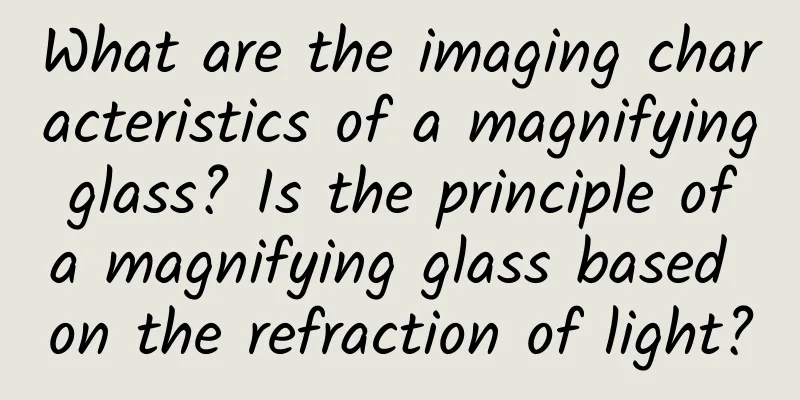What are the imaging characteristics of a magnifying glass? Is the principle of a magnifying glass based on the refraction of light?

|
Magnifying glasses are widely used in people's daily life and production. They can also be used for jewelry certification testing, substrate surface quality, color correction, etc. Magnifying glasses can be divided into two types according to their appearance: portable magnifying glasses and desktop magnifying glasses. Let's take a closer look at the imaging characteristics and principles of magnifying glasses. Contents of this article 1. What are the imaging characteristics of a magnifying glass? 2. Is the principle of a magnifying glass based on the refraction of light? 3. Are reading glasses magnifying glasses? 1What are the imaging characteristics of a magnifying glass?A magnifying glass is a simple visual optical device used to observe tiny details of an object. It is a converging lens with a focal length much smaller than the clear vision distance of the eye. Its lens features are thick in the middle and thin at the edges, and transparent. The greater the convexity, the greater the magnification. The imaging features are magnification, upright, same-side, and virtual image. A magnifying glass is a convex lens that has the function of magnifying the image of an object. Using a magnifying glass to observe an object can see more details. Magnifiers can be divided into two types according to their appearance: portable magnifiers and desktop magnifiers. According to the user groups, they can be divided into four types: reading magnifiers for the elderly, magnifiers for children, portable magnifiers for outdoor use, and professional identification and measurement magnifiers. Magnifiers are widely used in people's daily life and production, and can also be used for jewelry certification testing, substrate surface quality, color correction, etc. 2Is the principle of a magnifying glass the refraction of light?Yes. A magnifying glass is a convex lens. In physics, both concave and convex lenses use the principle of light refraction to form images. Convex lenses have the effect of converging light. Convex lenses are thick in the middle and thin on both sides; concave lenses are the opposite. Convex lenses are used to magnify images, focus, and make telescopes, microscopes, aging glasses, etc. Concave lenses are used to diverge light, reduce images, and make myopia glasses. Refraction of light refers to the change in the direction of propagation of light when it is incident obliquely from one medium to another, causing the light to be deflected at the boundary between different media (the deflection angle of light is the largest in the air). Characteristics: The refraction of light, like the reflection of light, occurs at the junction of two media, but the reflected light returns to the original medium, while the refracted light enters another medium. Since light propagates at different speeds in two different substances, the propagation direction changes at the junction of the two media, which is the refraction of light. In the refraction phenomenon, the light path is reversible. Note: At the boundary between two media (but sometimes there is no boundary), not only refraction but also reflection occurs. For example, in water, part of the light will be reflected back and part of the light will enter the water. The speed of light of the reflected light is the same as that of the incident light, but the speed of light of the refracted light is different from that of the incident light. 3Are reading glasses magnifying glasses?Reading glasses are magnifying glasses, and both are convex glasses. Reading glasses can correct vision and protect the eyes. Elderly people with myopia can get reading glasses at the optical shop. Many elderly people often use magnifying glasses to read books and newspapers, which is actually very harmful to the eyes. |
<<: This time, I'll give you a reason to eat crayfish
Recommend
5 minutes to relieve breast engorgement
If the mother does not breastfeed as soon as poss...
Why do I have lower abdominal pain after having an abortion?
Abortion is now a very common operation in medici...
What is the fastest way to remove kiss marks?
Everyone knows that today's society is a very...
What can I drink to treat dysmenorrhea?
The vast majority of causes of dysmenorrhea are c...
Causes of left back pain in women
There are many reasons for women's left back ...
How to reduce the size of the nipples?
Some women have very large nipples. If they don’t...
Picture of fetus in the womb
During the ten months of pregnancy, the fetus is ...
What are the causes of painful urination in women and how to deal with it?
Physical health is a very important part of peopl...
What to do if ovulation is not good at 37 years old
When women reach the age of 37, their body functi...
Unveiling the secrets of interventional treatment for vascular malformations: safe, accurate, and multiple?
Author: Shen Gang, Chief Physician, Children'...
Was Romance of the Three Kingdoms written in the Ming Dynasty? What was the author and title of the opening poem of Romance of the Three Kingdoms?
The Romance of the Three Kingdoms uses characters...
Bleeding five years after hysterectomy
The uterus is the main reproductive organ of wome...
What are the causes of postmenstrual vaginal bleeding?
Vaginal bleeding is a common symptom of female re...
How to take care of a woman in her forties
Everyone wants to have a good face and a beautifu...









